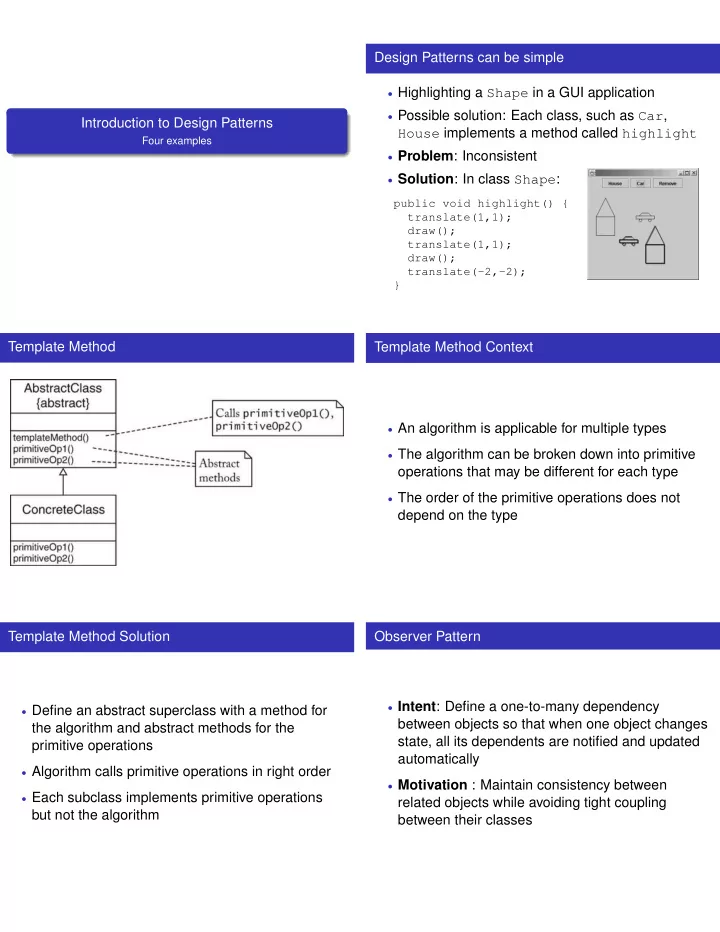

Design Patterns can be simple • Highlighting a Shape in a GUI application • Possible solution: Each class, such as Car , Introduction to Design Patterns House implements a method called highlight Four examples • Problem : Inconsistent • Solution : In class Shape : public void highlight() { translate(1,1); draw(); translate(1,1); draw(); translate(-2,-2); } Template Method Template Method Context • An algorithm is applicable for multiple types • The algorithm can be broken down into primitive operations that may be different for each type • The order of the primitive operations does not depend on the type Template Method Solution Observer Pattern • Intent : Define a one-to-many dependency • Define an abstract superclass with a method for between objects so that when one object changes the algorithm and abstract methods for the state, all its dependents are notified and updated primitive operations automatically • Algorithm calls primitive operations in right order • Motivation : Maintain consistency between • Each subclass implements primitive operations related objects while avoiding tight coupling but not the algorithm between their classes
Observer Class Diagram Observer - Participants • Subject • Knows its observers • Provides interface for attaching, detaching and notifying its observers • Observer • Defines an updating interface for observers • Concrete subject • Stores state of interest to concrete observers • Notifies observers when state changes • Concrete observer • Maintains a reference to its concrete subject • Stores state that corresponds to the state of the subject • Implements Observer updating interface Observer Sequence Diagram Observer - Consequences • Abstract coupling between subject and observer • Permits changing number of observers dynamically • Supports broadcast communication • Can have observers depend upon more than one subject • Need additional protocol to indicate what changed • Not all observers participate in all changes • Dangling references when subject is deleted • Notify observers when subject is deleted Composite Pattern Composite Class Diagram • Intent : Compose objects into tree structures representing part-whole hierarchies • Clients deal uniformly with individual objects and hierarchies of objects • Motivation : Applications that have recursive groupings of primitives and groups • Drawing programs, file systems • Operations on groups are different than primitives but users treat them in the same way
Decorator Pattern Composite - Consequences • Whenever client expects a primitive it can accept • Intent: Attach additional responsibilities to an a composite object dynamically • Client is simplified by removing tag-case • Provide a flexible alternative to subclassing for extending functionality statements to identify parts of the composition • Motivation: Want to add responsibility to individual • Easy to add new components by subclassing, objects not to entire classes client does not change • Add properties like border, scrolling, etc to any user interface component as needed • If compositions are to have restricted sets of components run-time checking is needed Decorator Participants Decorator Class Diagram • Component: defines the interface for objects that can have responsibilities added to them dynamically • Concrete component: Defines an object to which additional responsibilities can be attached • Decorator: Maintains a reference to a component object and defines an interface that conforms to Component • Concrete decorator: Adds responsibilities to the component Decorator Object Diagram Decorator - Applicability • Add responsibilities to individual objects dynamically and transparently • Without affecting other objects • For responsibilities that can be withdrawn • When subclass extension is impractical • Avoid combinatorial explosion of possible extensions • Class definition may be hidden or otherwise unavailable for subclassing
Decorator - Liabilities Decorator - Benefits • More flexibility than static inheritance • From object identity point of view, a decorated component is not identical • Can add and remove responsibilities dynamically • Decorator acts as a transparent enclosure • Can handle combinatorial explosion of possibilities • Cannot rely on object identity when using decorators • Avoids feature laden classes high up in the hierarchy • Lots of little objects • Pay as you go when adding responsibilities • Often result in systems composed of many look alike objects • Can support unforeseen features • Differ in the way they are interconnected, not in class or value of variables • Decorators are independent of the classes they decorate • Can be difficult to learn and debug • Functionality is composed in simple pieces
Recommend
More recommend